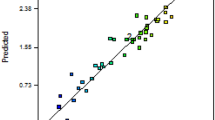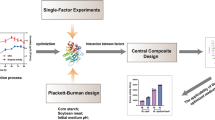Abstract
A sequential optimization strategy, based on statistical experimental designs, was used to enhance the production of riboflavin by recombinant Bacillus subtilis RH44. In the first instance, the medium components were optimized in shake flask cultures. After preliminary experiments of nitrogen source selection, the two-level Plackett–Burman (PB) design was implemented to screen medium components that significantly influence riboflavin production. Among the 15 variables tested, glucose, NaNO3, K2HPO4, ZnSO4, and MnCl2 were identified as the most significant factors (confidence levels above 95%) for riboflavin production. The optimal values of these five variables were determined by response surface methodology (RSM) based on the central composite design (CCD). The validity of the model developed was verified, and the optimum medium led to a maximum riboflavin concentration of 6.65 g/l, which was 44.3 and 76.4% higher than the improved medium and the basal medium, respectively. A glucose-limited fed-batch culture profile in a 5-l fermentor was consequently designed according to the above optimum medium in shake flasks. A final riboflavin concentration of 16.36 g/l was obtained in 48 h, which further verified the practicability of this optimum strategy.




Similar content being viewed by others
References
Abdel-Fattah YR, Saeed HM, Gohar YM, El-Baz MA (2005) Improved production of Pseudomonas aeruginosa uricase by optimization of process parameters through statistical experimental designs. Process Biochem 40:1707–1714
Amanullah A, McFarlane CM, Emery AN, Nienow AW (2001) Scale-down model to simulate spatial pH variations in large-scale bioreactors. Biotechnol Bioeng 73:390–399
Bacher A, Baur R, Eggers U, Harders HD, Otto MK, Schnepple H (1980) Riboflavin synthases of Bacillus subtilis. Purification and properties. J Biol Chem 255:632–637
Bretzel W, Schurter W, Ludwig B, Kupfer E, Doswald S, Pfister M, van Loon APGM (1999) Commercial riboflavin production by recombinant Bacillussubtilis: down-stream processing and comparison of the composition of riboflavin produced by fermentation or chemical synthesis. J Ind Microbiol Biotechnol 22:19–26
Chen T, Wu QL, Li XJ, Zhao XM (2006) The effects of different fed-batch process on vitamin B2 production in Bacillus subtilis. Trans Tian** Univ 6(Suppl):7–12
De Coninck J, Bouquelet S, Dumortier V, Duyme F, Denantes VI (2000) Industrial media and fermentation process for improved growth and protease production by Tetrahymena thermophila BIII. J Ind Microbiol Biotechnol 24:285–290
Coquard D, Huecas M, Ott M, van Dijl JM, van Loon APGM, Hohmann HP (1997) Molecular cloning and characterization of the ribC gene from Bacillus subtilis: a point mutation in ribC results in riboflavin overproduction. Mol Gen Genet 254:81–84
Ertrk E, Erkmen O, Oner MD (1998) Effects of various supplements on riboflavin production by Ashbya gossypii in Whey. Turk J Eng Environ Sci 22:371–376
Ezeji TC, Qureshi N, Blaschek HP (2004) Acetone butanol ethanol (ABE) production from concentrated substrate: reduction in substrate inhibition by fed-batch technique and product inhibition by gas strip**. Appl Microbiol Biotechnol 63:653–658
Gheshlaghi R, Scharer JM, Moo-Young M, Douglas PL (2005) Medium optimization for hen egg white lysozyme production by recombinant Aspergillus niger using statistical methods. Biotechnol Bioeng 90:754–760
Glaser P, Danchin A, Kunst F, Zuber P, Nakano MM (1995) Identification and isolation of a gene required for nitrate assimilation and anaerobic growth of Bacillus subtilis. J Bacteriol 177:1112–1115
Goel A, Lee J, Domach MM, Ataai MM (1995) Suppressed acid formation by cofeeding of glucose and citrate in Bacillus cultures: emergence of pyruvate kinase as a potential metabolic engineering site. Biotechnol Prog 11:380–385
Hoffmann T, Troup B, Szabo A, Hungerer C, Jahn D (1995) The anaerobic life of Bacillus subtilis: cloning of the genes encoding the respiratory nitrate reductase system. FEMS Microbiol Lett 131:219–225
Hümbelin M, Griesser V, Keller T, Schurter W, Haiker M, Hohmann H-P, Ritz H, Richter G, Bacher A, van Loon APGM (1999) GTP cyclohydrolase II and 3,4-dihydroxy-2-butanone 4-phosphate synthase are rate-limiting enzymes in riboflavin synthesis of an industrial Bacillus subtilis strain used for riboflavin production. J Ind Microbiol Biotechnol 22:1–7
Jurgen B, Tobisch S, Wumpelmann M, Gordes D, Koch A, Thurow K, Albrecht D, Hecker M, Schweder T (2005) Global expression profiling of Bacillus subtilis cells during industrial-close fed-batch fermentations with different nitrogen sources. Biotechnol Bioeng 92:277–298
Kaiser J, Schramek N, Eberhardt S, Puttmer S, Schuster M, Bacher A (2002) Biosynthesis of vitamin B2 An essential zinc ion at the catalytic site of GTP cyclohydrolase II. Eur J Biochem 269:5264–5270
Kalingan AE, Liao CM (2002) Influence of type and concentration of flavinogenic factors on production of riboflavin by Eremothecium ashbyii NRRL 1363. Bioresour Technol 82:219–224
Kennedy M, Krouse D (1999) Strategies for improving fermentation medium performance: a review. J Ind Microbiol Biotechnol 23:456–475
Khan S, Misra AK, Tripathi CK, Mishra BN, Bihari V (2006) Response surface optimization of effective medium constituents for the production of alkaline protease from a newly isolated strain of Pseudomonas aeruginosa. Indian J Exp Biol 44:151–156
Kis K, Bacher A (1995) Substrate channeling in the lumazine synthase/riboflavin synthase complex of Bacillus subtilis. J Biol Chem 270:16788–16795
Koizumi S, Yonetani Y, Maruyama A, Teshiba S (2000) Production of riboflavin by metabolically engineered Corynebacterium ammoniagenes. Appl Microbiol Biotechnol 53:674–679
Lee J, Goel A, Ataai MM, Domach MM (1997) Supply-side analysis of growth of Bacillus subtilis on glucose-citrate medium: feasible network alternatives and yield optimality. Appl Environ Microbiol 63:710–718
Li XJ, Chen T, Chen X, Zhao XM (2006) Redirection electron flow to high coupling efficiency of terminal oxidase to enhance riboflavin biosynthesis. Appl Microbiol Biotechnol 73:374–383
Lim SH, Ming H, Park EY, Choi JS (2003) Improvement of riboflavin production using mineral support in the culture of Ashbya gossypii. Food Technol Biotechnol 41:137–144
Marks E (1968) Profile analysis in a two-way classification problem. Multivar Behav Res 3:95–106
Montgomery DC (1997) Design and analysis of experiments, 4th edn. Wiley, New York
Nakano MM, Yang F, Hardin P, Zuber P (1995) Nitrogen regulation of nasA and the nasB operon, which encode genes required for nitrate assimilation in Bacillus subtilis. J Bacteriol 177:573–579
Nakano MM, Hoffmann T, Zhu Y, Jahn D (1998) Nitrogen and oxygen regulation of Bacillus subtilisnasDEF encoding NADH-dependent nitrite reductase by TnrA and ResDE. J Bacteriol 180:5344–5350
Niccolai A, Fontani S, Kapat A, Olivieri R (2003) Maximization of recombinant Helicobacter pylori neutrophil activating protein production in Escherichia coli: improvement of a chemically defined medium using response surface methodology. FEMS Microbiol Lett 221:257–262
Ogawa K, Akagawa E, Yamane K, Sun ZW, LaCelle M, Zuber P, Nakano MM (1995) The nasB operon and nasA gene are required for nitrate/nitrite assimilation in Bacillus subtilis. J Bacteriol 177:1409–1413
Özbas T, Kutsal T (1986) Comparative study of riboflavin production from two microorganisms Eremothecium ashbyii and Ashbya gossypii. Enzyme Microb Technol 8:593–596
Perkins JB, Sloma A, Hermann T, Theriault K, Zachgo E, Erdenberger T, Hannett N, Chatterjee NP, Williams V II, Rufo GA Jr, Hatch R, Pero J (1999a) Genetic engineering of Bacillus subtilis for the commercial production of riboflavin. J Ind Microbiol Biotechnol 22:8–18
Perkins JB, Sloma A, Pero JG, Hatch RT, Hermann T, Erdenberger T (1999b) Bacterial strains which overproduce riboflavin. US Patent 5925538A
Plackett RL, Burman JP (1946) The design of optimum multi-factorial experiments. Biometrika 33:305–325
Rado TA, Hoch JA (1973) Phosphotransacetylase from Bacillus subtilis: purification and physiological studies. Biochim Biophys Acta 321:114–125
Rathi P, Goswami VK, Sahai V, Gupta R (2002) Statistical medium optimization and production of hyperthermostable lipase from Burkholderia Cepacia in a bioreactor. J Appl Microbiol 93:930–936
Ren J, Kotaka M, Lockyer M, Lamb HK, Hawkins AR, Stammers DK (2005) GTP cyclohydrolase II structure and mechanism. J Biol Chem 280:36912–36919
Stahmann KP, Revuelta JL, Seulberger H (2000) Three biotechnical processes using Ashybya gossypii, Candida famata, or Bacillus subtilis compete with chemical riboflavin production. Appl Microbiol Biotechnol 53:509–516
Sun G, Sharkova E, Chesnut R, Birkey S, Duggan MF, Sorokin A, Pujic P, Ehrlich SD, Hulett FM (1996) Regulators of aerobic and anaerobic respiration in Bacillus subtilis. J Bacteriol 178:1374–1385
Tsapatsaris S, Kotzekidou P (2004) Application of central composite design and response surface methodology to the fermentation of olive juice by Lactobacillus plantarum and Debaryomyces hansenii. Int J Food Microbiol 95:157–168
Ujita S, Kimura K (1982) Glucose-6-phosphate dehydrogenase, vegetative and spore Bacillus subtilis. Methods Enzymol 89:258–261
Vaidya R, Vyas P, Chhatpar HS (2003) Statistical optimization of medium components for the production of chitinase by Alcaligenes xylosoxydans. Enzyme Microb Technol 33:92–96
Venugopal P, Chandra TS (2000) Statistical optimization of medium components for enhanced riboflavin production by a UV-mutant of Eremothecium ashbyii. Process Biochem 36:31–37
Vohra A, Satyanarayana T (2002) Statistical optimization of the medium components by response surface methodology to enhance phytase production by Pichia anomala. Process Biochem 37:999–1004
Wray LV Jr, Ferson AE, Rohrer K, Fisher SH (1996) TnrA, a transcription factor required for global nitrogen regulation in Bacillus subtilis. Proc Natl Acad Sci U S A. 93:8841–8845
Zamboni N, Mouncey N, Hohmann HP, Sauer U (2003) Reducing maintenance metabolism by metabolic engineering of respiration improves riboflavin production by Bacillus subtilis. Metab Eng 5:49–55
Acknowledgments
This research was supported by the National Natural Science Foundation of China (NSFC-20536040), the National Project of Key Fundamental Research (2003Cb716003 and 2007CB707802), and the Development Project of Science and Technology of Tian** (05YFGZGX04500). The authors sincerely thank Mr. A.O. Babatunde of University College Dublin, Ireland for his help in English editing.
Author information
Authors and Affiliations
Corresponding author
Rights and permissions
About this article
Cite this article
Wu, QL., Chen, T., Gan, Y. et al. Optimization of riboflavin production by recombinant Bacillus subtilis RH44 using statistical designs. Appl Microbiol Biotechnol 76, 783–794 (2007). https://doi.org/10.1007/s00253-007-1049-y
Received:
Revised:
Accepted:
Published:
Issue Date:
DOI: https://doi.org/10.1007/s00253-007-1049-y




